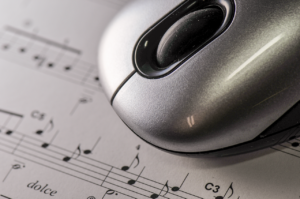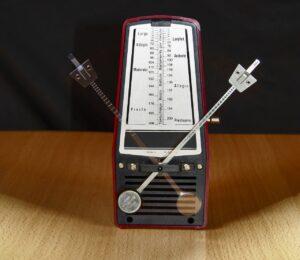Estimated reading time 2 minutes
Table of Contents
Introduction
Do you want to know the best way to practice with a metronome? Do you want to know what a metronome even is? A metronome is one of the best practice tools invented for musicians, because it helps you play with a steady beat. Nothing will make you sound like a professional faster than playing with a steady beat, and nothing will make you sound terrible faster than playing with a choppy beat. Keep reading The 5 Best Effortlessly Easy Metronome Practice Tips to learn how to play with a steady beat.
This article uses musical terms. For definitions, see the Glossary at the end of the post.

Easy Metronome Practice Tips #1: What’s a Metronome?
A metronome is a machine that makes a clicking sound at a regular rate. It’s used as an aid during practice to help you work your songs up to speed while maintaining a constant beat:
- Originally, the clicking sound was produced by a mechanical device that was first marketed by Johann Maelzel at the beginning of the 19th century.
- Now, in addition to mechanical versions, they also can be electronic devices or downloadable apps. For an online metronome: click here.
- The rate of the clicking is adjustable and is measured in beats per minute (bpm), such as 60 bpm which is one beat per second.
Metronomes have a broad range of speeds, in some cases from 25 beats per minute to over 200 beats per minute, for example:
- 50 bpm (tempo mark = largo) is a slow tempo.
- 70 bpm (tempo mark = adagio) is medium slow.
- 100 bpm (tempo mark = andante) is moderately fast.
- 120 bpm (tempo mark = allegro) is fast.
- 200+ bpm (tempo mark = presto) is very fast.

Easy Metronome Practice Tips #2: The Five Best Tips
When practicing with the metronome, you need to prioritize accuracy over speed. The five best metronome practice tips are:
- Start slowly, somewhere around 40 to 60 beats per minute.
- Gradually increase your tempo in 5 bpm increments until you start making mistakes.
- Stop and practice at the tempo 5 bpm below where you stopped.
- Once you’ve got it, start increasing the tempo (stopping and correcting mistakes as necessary), until you’ve reached your target tempo.
- Pro Tip: Practice 5 to 10 bpm above your target tempo so that you’ll be extra comfortable at your target tempo when you perform.
If you want to play in a band or other ensemble, you must learn how to sync with the beat, and playing with a metronome will help you learn how to do that.
Final Thoughts on “The 5 Best Effortlessly Easy Metronome Practice Tips”
Takeaway points:
- Make sure your playing is accurate before you speed up.
- Nothing will make you sound like a professional faster than performing with a steady beat, and nothing will make you sound terrible faster than performing with a choppy beat.
- Start slowly and work up to your target tempo.
Have fun playing!
Related Posts
- What Is the Basic Idea of Tempo in Music?
- I’m Having a Hard Time Keeping a Steady Beat
- D’you Want Some Music Tips and Tricks I’ve Learned Over the Years?
© 2024 Geoffrey Keith
Join me for in-person or online lessons today!
Back to the All-Purpose Music Tips and Topics category blogs page
Glossary
Harmony and Melody Tune Differently
Have you ever felt embarrassed because someone said you sang or played out of tune? Does harmonizing seem like a puzzle you can’t solve? Knowledge is power. I will show you how harmony and melody tune differently, and how it impacts singing and playing in tune. Estimated reading time 4 minutes.
Read MoreSinging Shape Note Solfege Mixolydian Melodies
Do you want to sing blues, gospel, or even mediaeval melodies? Are you confused about how modes work? Modes have the exotic feel of world music and music from ancient times. "Singing Shape Note Solfege Mixolydian Melodies" helps you discover the sound of the modes. Estimated reading time 4 minutes.
Read MoreWhat’s a Good Alternative to a Metronome for Practice Sessions?
Teachers, do you have students who can’t use a metronome and can’t keep a steady beat? We all know how valuable metronome practice can be. However, it can be tricky for students to sync with a metronome, and many students flat out refuse to work with them. Click to answer the question, “What’s a good alternative to a metronome for practice sessions?” Estimated reading time 2 minutes.
Read MoreExplore Bach’s Epic Orchestral Music in Less Than Four Minutes
Would you like to explore Johann Sebastian Bach’s instrumental music but don’t have a lot of time to spend doing it? Bach is one of the most celebrated composers in classical music. He’s best known for writing delightfully complex polyphonic music. Keep reading to explore Bach’s epic orchestral music in less than four minutes. Estimated reading time 3 minutes.
Read More




